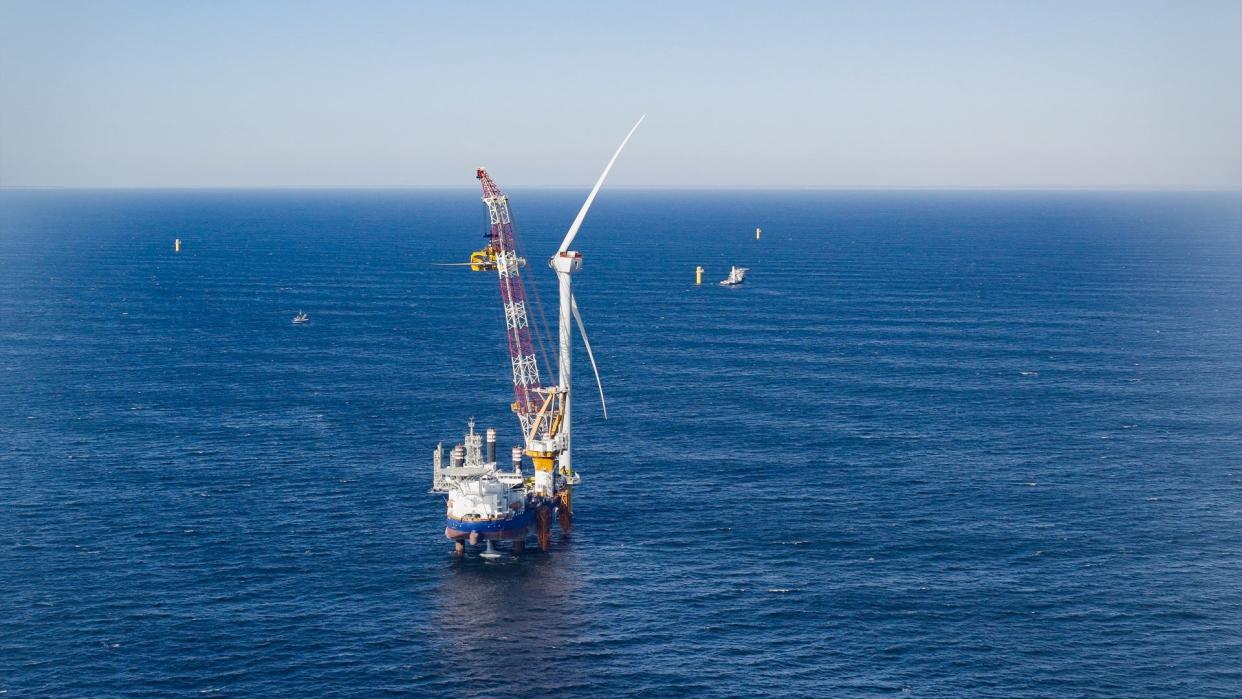Will offshore wind turbines spoil ocean views for Newport mansions? This lawsuit things so.
NEWPORT – Preservation groups in Newport and Block Island have filed suit against the federal government over the approval of two large offshore wind farms in the ocean waters off Rhode Island, arguing that the project’s towering turbines would ruin views from the Newport mansions, the Southeast Lighthouse and other historic sites.
The Preservation Society of Newport County, which owns 11 historic properties, and the Southeast Lighthouse Foundation on Block Island filed appeals this week of the Bureau of Ocean Energy Management’s approval of the South Fork Wind Farm and Revolution Wind.
“We support green energy,” Trudy Coxe, CEO of the Preservation Society, said in a statement. “For two years we pointed out serious problems with the federal permitting process, but BOEM never listened. Green energy projects need not come at the unnecessary loss to our community’s irreplaceable character and sense of place.”
The lawsuits were filed in federal court in the District of Columbia. Both groups are being represented by Cultural Heritage Partners, a firm that has also worked for Newport, Block Island and Nantucket on offshore wind impacts.
As part of its evaluations of the wind farms, BOEM considered visual impacts along the southern New England coastline. According to simulations included in the review, turbines would be visible from Cliff Walk, Sachuest Point National Wildlife Refuge and other historical and cultural sites in and around Newport during the day and their lights would be visible at night. They would also be visible from the Southeast Lighthouse on Block Island.
The appeals argue that even though the review process concluded that the turbines would be visible from shore, the federal government failed to eliminate or attempt to mitigate the visual impacts.
The groups say that the federal government also failed to consider the cumulative impacts of not only the two wind farms named in the lawsuits but also several others in the region that have either won approval already or are going through the permitting process. In total, hundreds of wind turbines, each standing as much as 800 feet tall at its highest point, would be installed in the waters roughly between Block Island and Martha’s Vineyard.
The Southeast Lighthouse Foundation said BOEM conducted “sham regulatory reviews” that were rushed by political pressure from the White House. Dr. Gerry Abbott, chairman of the foundation board, described the development of offshore wind as “a complete industrialization of our ocean view.”
The Biden administration is pushing to develop 30 gigawatts of offshore wind energy by the end of the decade in an effort to help decarbonize the nation’s electric system and rein in greenhouse gas emissions. At the same time, Rhode Island and other states have set ambitious climate goals that require steep increases in the use of renewable energy.
Because much of the Northeast is densely populated, solar and onshore wind aren’t seen to be as viable as offshore wind, which is considered a better bet in the region because winds on the Outer Continental Shelf are strong and the waters are relatively shallow.

What are the two projects the suit opposes?
The first offshore wind farm in the nation, a 5-turbine test project near Block Island, was completed in 2016. The first two utility-scale projects that would supply significant amounts of energy to the grid started offshore construction this past summer. Both projects – 62-turbine Vineyard Wind and the 12-turbine South Fork Wind Farm – have already installed turbines. Revolution Wind, which is aiming to be the third project in the water and would have 65 turbines, has begun construction onshore along the route of its transmission cable.
South Fork and Revolution, the two projects subject to the appeals, are being developed by a joint venture between Danish offshore wind company Orsted and New England utility Eversource. Vineyard Wind, which is further from the Rhode Island coast, is not named in the suits.
Neither Orsted and Eversource nor BOEM immediately responded to requests for comments.
Asked why the appeals are being filed now, two years after South Fork received its key permit from BOEM, a lawyer with Cultural Heritage Partners said the government never notified his clients about the impacts of the wind farms when the review process started.
“We made good faith subsequent efforts to work with BOEM and Orsted to fix their errors in the permitting process, but they declined,” said Greg Wurkheiser, founding partner with the law firm.
When asked about compensation, he said it’s too early to talk about mitigation when the government has failed to fully assess the negative visual impacts.
This article originally appeared on The Providence Journal: Newport Mansions file lawsuit to stop wind turbine construction
